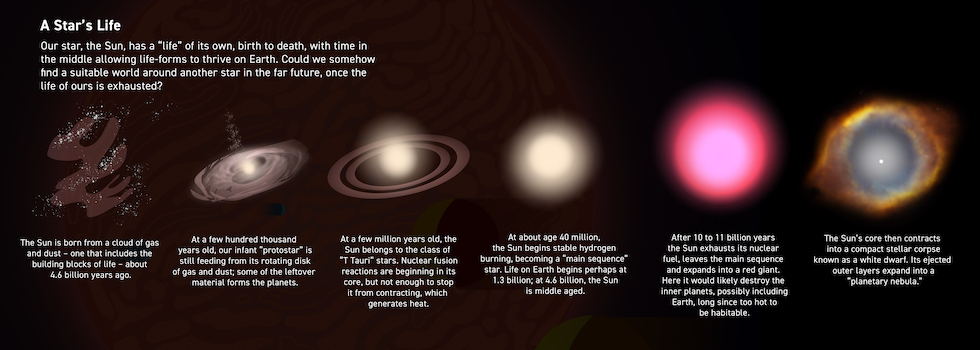6 min read

The future is full of questions for us earthly life-forms. How far can we take our search for life elsewhere? Which new technologies are best for detecting life? Could we ever visit planets beyond our solar system?
And if we find life beyond Earth, how will it change us?
Scientists and technological experts suggest a variety of possibilities, but many seem to agree on at least one observation: The search for life is accelerating, sprouting new technologies and new ideas even as our view of the cosmos grows sharper.
A question often asked, so far without an answer, is whether we’ll detect the first signs of life on another body within our solar system, or on an exoplanet – a planet orbiting another star.
Exploration of the solar system has the advantage of landing on planets, moons, or asteroids, and collecting samples for analysis. For the planets beyond our solar system, remote detection of signs of life will have to suffice.
Still, we might have good reason to expect the first detection will come from an exoplanet, said Mary Voytek, director of NASA’s Astrobiology Program at the agency’s headquarters in Washington.
Although solar system planets are more directly accessible, finding life among them poses enormous technical challenges – whether we’re seeking life on Mars or on Jupiter’s moon, Europa, or Saturn’s Enceladus.
“The best hope on Mars is the subsurface,” Voytek said. “How long will it take before we’re able to drill into the subsurface? For Enceladus and Europa, we’re talking about being in a subsurface ocean below kilometers of ice. How soon will it be before we actually get into those? It becomes more an issue of access and not of, I think, greater probability.”
Exoplanets, on the other hand, despite the challenges of remote detection, offer a vast number of targets: thousands of planets confirmed so far in our galaxy, which likely contains hundreds of billions.
“Think about all the exoplanets out there,” she said. “Suddenly we have this giant, vast possibility of things to search on.”
And the right technology to conduct such a search is just coming online. NASA’s James Webb Space Telescope is already adding to inventories of ingredients in exoplanet atmospheres; more powerful and sensitive observatories are being readied for the future search for life signs – also called biosignatures.
“In the short term, of course, we’re hoping [the Webb telescope] is able to make detection of biosignature gases in the atmospheres of a couple of terrestrial worlds,” said Michael Way, a physical scientist at NASA’s Goddard Institute for Space Studies in New York who creates computer models of possible exoplanet atmospheres.
Hopes are also high for the next generation of ground-based telescopes, massive instruments 100 or 130 feet (30 or 40 meters) wide.
“It’s not clear to me that the instruments coming online in the early 2030s will be capable of that or not,” Way said. “There are calculations that show it’s possible.”
Farther off, one of the most anticipated life-seeking technologies is a possible future space telescope, NASA’s Habitable Worlds Observatory. Now in the early conceptual stages, the proposal is an answer to recommendations from the National Academy of Sciences as part of a “decadal survey” released in 2021. It outlines scientific priorities for the decade ahead, including the discovery and exploration of habitable planets.
The observatory’s imaging capability, well beyond that of any existing space telescope, would be used to observe 25 potentially Earth-like planets to search for signs of life.
Such initiatives, combined with missions to come, like NASA’s Mars Sample Return and the exploration of icy moons in the outer solar system, represent a turning point for our species, said Shawn Domagal-Goldman, the NASA program scientist for the program responsible for early development of the Habitable Worlds mission concept.
“We’re going to tell the story of life in the cosmos by using that unprecedented imaging capability – to study the long-term evolution of galaxies, the stars they’re made of, the matter that makes up those stars, and to help us understand how habitable worlds came to be,” he said. “And we’re going to search for signs of life on those habitable worlds.”
More exotic ideas for decades or even centuries ahead remain speculative, but include sending probes to other star systems. One private-sector concept, called Breakthrough Starshot, would use lasers to push a fleet of tiny “light sail” probes to a fraction of light speed, perhaps to reach the nearest star, Proxima Centauri, in 20 to 30 years.

But sending humans to other star systems, Way said, remains firmly in the realm of science fiction. While further human exploration of the solar system in decades ahead seems within reach, no existing or planned technology could preserve human life for the tens of thousands of years it might take to reach another star.
A shortcut to finding life, of course, would be picking up signals or evidence of intelligent life. “Technosignatures,” or signs of technological civilization, are gaining renewed attention from scientists at NASA and around the world.
The search would not be limited to signals via radio, or even the broader light spectrum. They might include evidence of pollution or artificial chemicals in exoplanet atmospheres, “city lights” on a planet’s night side, large artificial structures passing in front of a star, constellations of satellites, or waste heat detected as infrared radiation.
“Advanced civilizations, any civilizations using energy need to emit waste heat,” said Ravi Kopparapu, a researcher at NASA’s Goddard Space Flight Center in Greenbelt, Maryland, who focuses much of his work on the hunt for non-radio technosignatures.
However the search plays out, whatever might be found, astronomer Jill Tarter, one of the world’s best-known seekers of intelligent life beyond Earth, hopes it will push humanity toward what she calls the “cosmic perspective.”
“We’re all Earthlings,” she said. “The cosmic perspective trivializes the differences among humans. So we need to become Earthlings, and act like that.”
In the very distant future Earth itself is, of course, expected to meet its demise. In about five billion years, our dying Sun should swell into a red-giant phase, engulfing some of its nearer planets and perhaps Earth along with them. By then, an increasingly hot Sun would have long-since rendered our planet uninhabitable in any case.
Would that end our chapter in the cosmic history of life? Maybe not. If humanity hasn’t become extinct by then, we might have migrated to another planetary system.
“Assuming we don’t exterminate ourselves in the meantime, we’ll find a way to go somewhere else,” Way said.
Such a story could, in fact, have been repeated many times throughout the history of the cosmos.
Search for Life
This article is one in a series about how NASA is searching for life in the cosmos.





